Exposure
“Exposure” is the act of exposing the image sensor to light. By adjusting the amount of light, you can make a photograph of a bright sunlit scene look dark, or a shot of a dark interior look bright. DSLR Cameras have auto-exposure systems that automatically produce photographs of optimal brightness. You can use this system for optimal results with both brightly-lit and poorly-lit subjects. This is referred to as “optimal exposure.” Believe it or not, this is determined by just three camera settings: aperture, ISO and shutter speed (the “exposure triangle”).
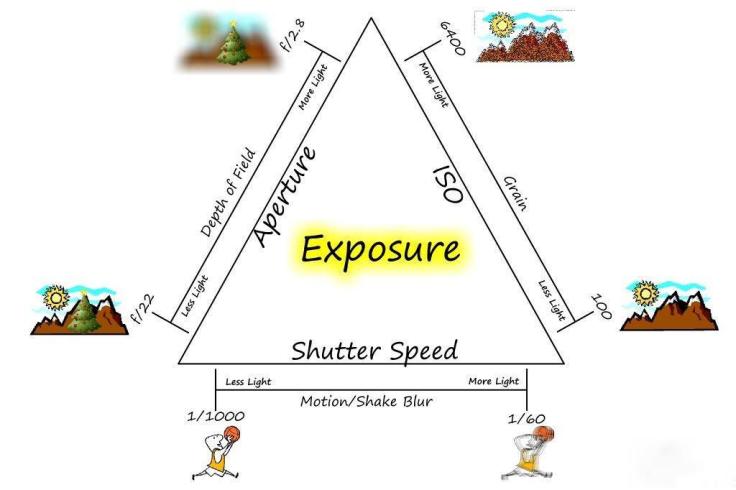
ISO ratings determine the image sensor’s sensitivity to light, each value of the rating represents a “stop” of light, and each incremental ISO number (up or down) represents a doubling or halving of the sensor’s sensitivity to light.
The Aperture controls the lens’ diaphragm, which controls the amount of light traveling through the lens to the film plane. The aperture setting is indicated by the f-number, whereas each f-number represents a “stop” of light.
The Shutter Speed indicates the speed in which the curtain opens then closes, and each shutter speed value also represents a “stop” of light. The shutter speed is measured in fractions of a second.
ISO
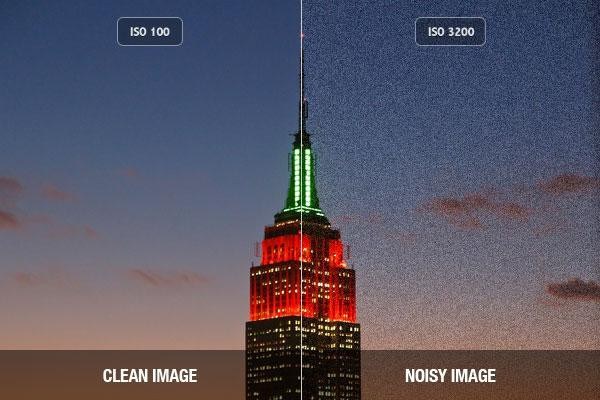
ISO speed is one of three settings that control how much light each exposure captures. The shutter speed controls how long the hole is open. Aperture controls the size of the hole. And ISO speed, as we mentioned, controls the light sensitivity of the film or sensor. By adjusting these settings to different light conditions, experienced photographers can get the clearest and sharpest shots.
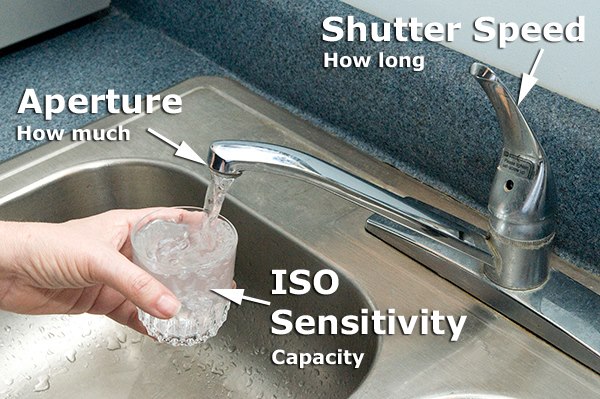
When you change your ISO setting, you’re adjusting your camera’s sensitivity to light.
A high ISO such as ISO 1,600 will produce a brighter picture than a lower ISO such as ISO 100. The drawback to increasing the ISO is that it makes the picture noisier. Digital noise is apparent when a photo looks grainy. Have you ever taken a picture at night with your cell phone or your pocket camera, and noticed that it looks really grainy? That is because the camera tried to compensate for the dark scene by choosing a high ISO, which causes more grain.
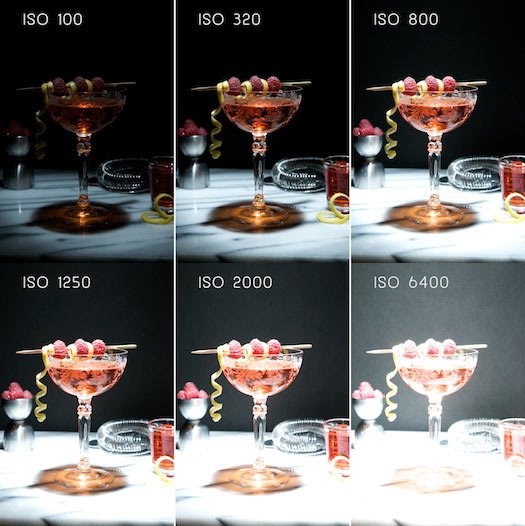
Finding the right ISO setting
First of all, you should know that a higher ISO typically translates to a noisy or “grainy” image, so as a general rule you want to use the lowest setting possible for your photos.

A lower ISO will usually produce more color-accurate, aesthetically pleasing images, but there are situations where a higher ISO is desirable. The proper ISO setting really depends on the level of lighting you’re shooting in and the visual effect you’re going for, so rather than relying on one over-arching rule, consult this list of tips:
If your subject is moving and you’re trying freeze the motion for a still, you’ll likely need a higher ISO setting to compensate for the high shutter speed and ensure your image gets enough light
If you’re going for more of a vintage aesthetic and want to add a little bit of grain to your photos, don’t be afraid to bump up the ISO a few notches
If you’re using a tripod to stabilize your camera you can usually get away with a slower shutter speed, which in turn allows you to use a lower ISO
If you’re shooting an image that doesn’t require a large depth-of-field, you can increase the camera’s aperture (thus allowing more light into the lens) and use a lower ISO
If you’re shooting with artificial light (i.e., using a flash) you can typically get away with a lower ISO setting
Sample Camera Displays
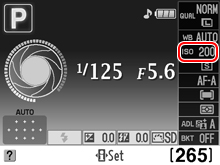
ISO sensitivity: Displayed as ISO 200, 400, 800, 1600, 3200…
APERTURE
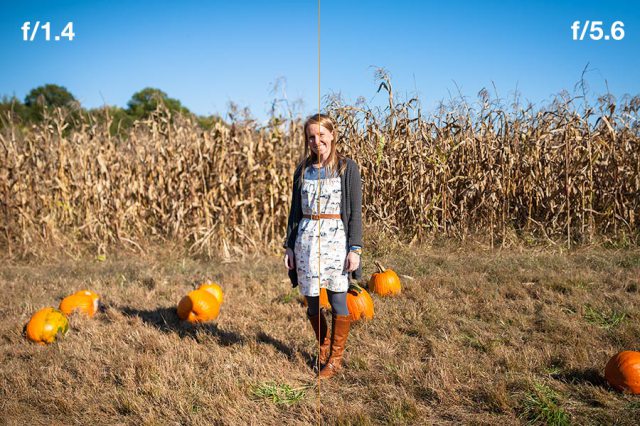
Aperture controls the brightness of the image that passes through the lens and falls on the image sensor. It is expressed as an f-number (written as “f/” followed by a number), such as f/1.4, f/2, f/2.8, /f4, f/5.6, f/8, f/11, f/16, f/22, or f/32.
Changing the f-number changes the size of the aperture, changing the amount of light that passes through the lens. The higher the f-number, the smaller the aperture and the less light that passes through the lens; the lower the f-number, the larger the aperture and the more light that passes through the lens. For example, changing the aperture from f/4 to f/5.6 halves the amount of light passing through the lens and halves the brightness of the image that falls on the image sensor.
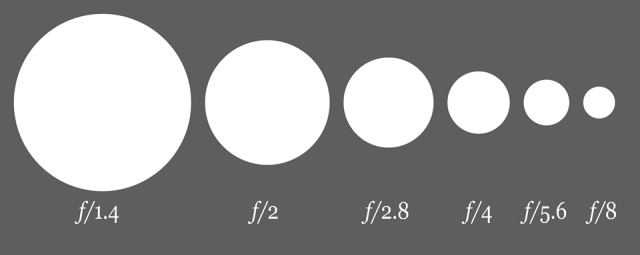
Changing the f-number also changes the distance in front of or behind the focus point that appears to be in focus. The higher the f-number, the greater the distance in front of and behind the focus point that appears to be in focus; on the other hand, the lower the f-number, the shorter the distance in front of and behind the focus point that appears to be in focus. The distance in front of and behind the focus point that appears to be in focus is referred to as “depth of field.”

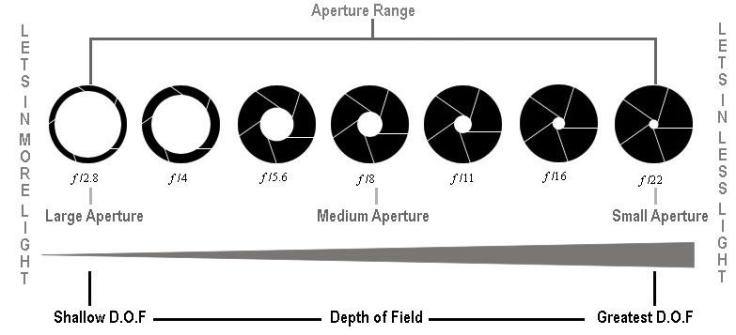
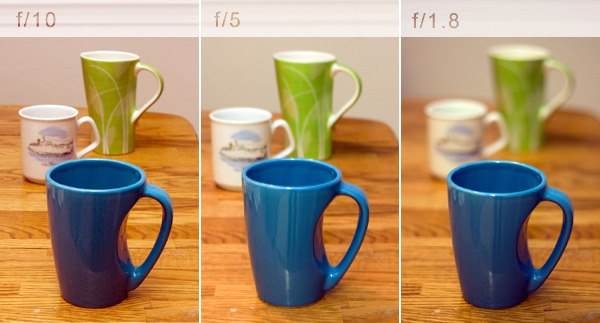
Sample Camera Displays
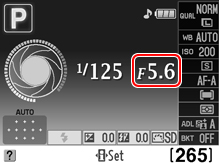
f-number: Shown as f/4, f/4.5, f/5, f/5.6, etc.
SHUTTER SPEED
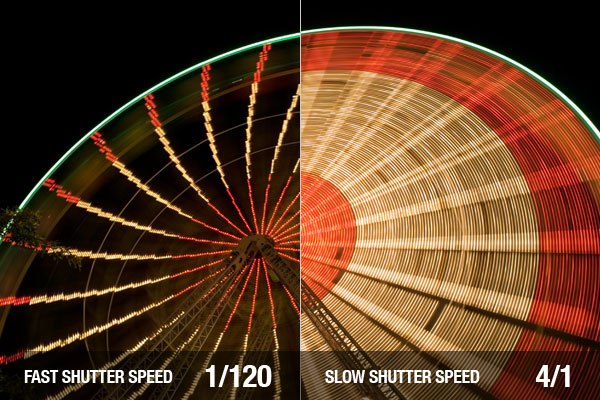
Shutter Speed is one of the three pillars of photography, the other two being ISO and Aperture. Shutter speed is where the other side of the magic happens – it is responsible for creating dramatic effects by either freezing action or blurring motion.
Shutter speed is what you want to change when you want to show movement in your picture or when you want to take an incredibly clear shot, a moment in time, without any blur of movement at all. The slower the shutter speed is, the more movement the camera will capture.
Aperture shutter speed and ISO together are what determines exposure because they both affect how much light is taken in while the picture is being taken. The most basic definition of shutter speed is how long the shutter takes to open and close.
The shutter is a small “curtain” in the camera that quickly rolls over the image sensor (the digital version of film) and allows light to shine onto the imaging sensor for a fraction of a second. The longer the shutter allows light to shine onto the image sensor, the brighter the picture since more light is gathered. A darker picture is produced when the shutter moves very quickly and only allows light to touch the imaging sensor for a tiny fraction of a second. The duration that the shutter allows light onto the image sensor is called the shutter speed, and is measured in fractions of a second. So a shutter speed of 1/2 of a second will allow more light to touch the image sensor and will produce a brighter picture than a shutter speed of 1/200 of a second. So if you’re taking a picture an it is too dark, you could use a slower shutter speed to allow the camera to gather more light.
Just as the aperture affects the exposure as well as the depth-of field, the shutter affects more than just the exposure. The shutter speed is also principally responsible for controlling the amount of blur in a picture.
THE FOCAL LENGTH VS. SHUTTER SPEED RULE
The simplest answer to how slow of a shutter speed you can use and still get a sharp picture is to use the 1/focal length rule. The shutter speed/focal length rule says you simply take the focal length you’re shooting at (let’s say 50mm, for an example), and make the denominator in your shutter speed. Simple! So if you’re shooting with a 50mm lens, the rule says that you shouldn’t pick a shutter speed slower than 1/50 if you want a sharp picture. So you could shoot at 1/80 or 1/100 and be just fine, but don’t go to 1/40 or 1/20.
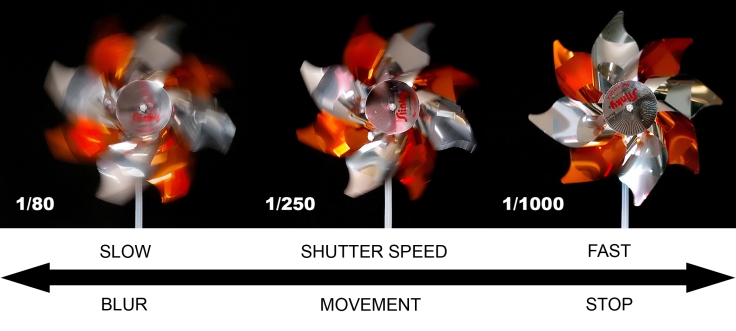
Another example: if you’re shooting at 200mm, the rule says you should not shoot slower than 1/200. So 1/400 or 1/640 or faster is fine, but don’t choose 1/180 or anything else under 1/200.
There are several issues with taking the 1/focal length rule as the final word on the subject: (1) If you are using a crop sensor camera, do you add the crop factor to the equation? (2) What about image stabilization, wouldn’t that allow you to achieve a sharper shot at a slower shutter speed? (3) Does the rule break down at very long and very short shutter speeds? The answer to all three of these questions, is “yes!”
Sample Camera Displays
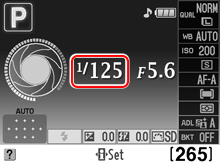
Shutter speed: Speeds faster than one second are shown as fractions (e.g.: …1/125, 1/160, 1/200, 1/250…). Some cameras may omit the numerator so that “1/125” becomes “125,” “1/250” becomes “250,” etc. Speeds slower than one second are shown by a double prime symbol following the value (e.g.: 1 ˝).
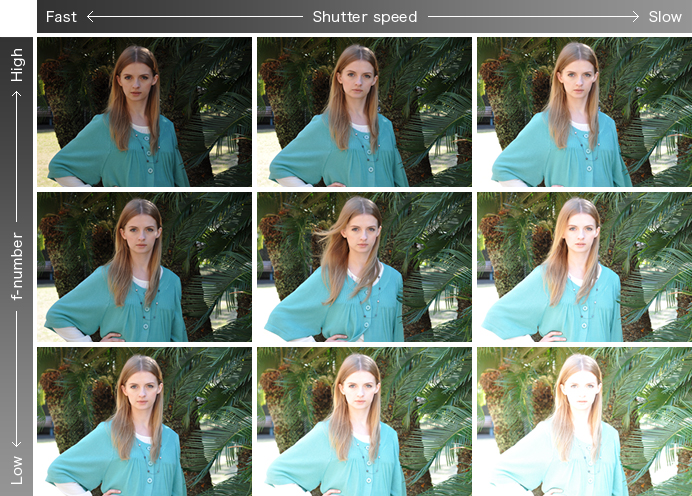
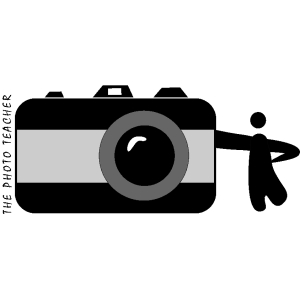

February 20, 2017 at 2:36 pm
Nice share of information here. I really find this information really helpful for me. Thanks a lot, dude. If you’re in New York City, we could help you on internet marketing, such as SEO, Social Networks, email marketing. Thanks. http://www.i1024.com
LikeLike
May 20, 2017 at 2:09 pm
This website was… how do I say it? Relevant!! Finally I have found something that helped me. Thank you!|
https://appcodemarket.com/product/air-soccer-challenge/
LikeLike
May 23, 2017 at 12:29 am
Aw, this was a very nice post. Spending some time and actual effort to make a superb article… but what can I say… I procrastinate a whole lot and don’t manage to get anything done.|
LikeLike